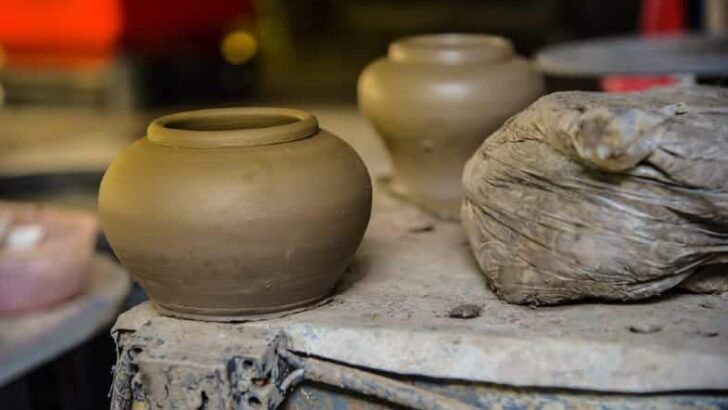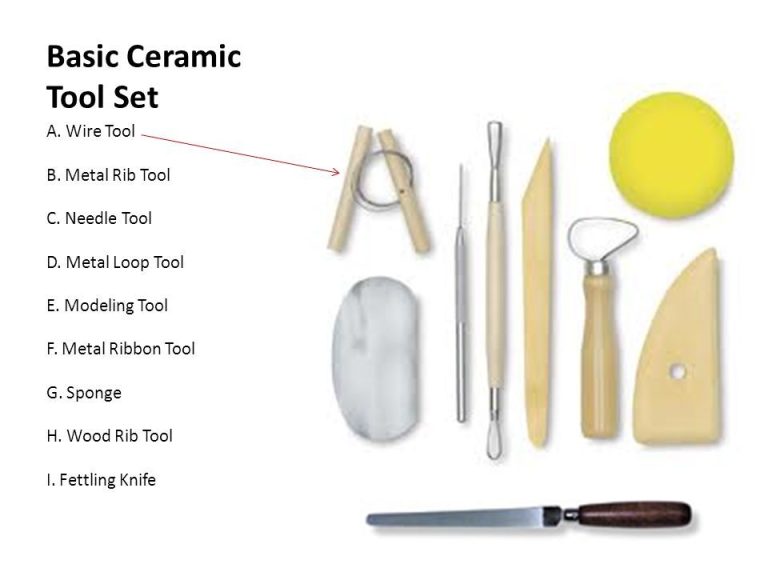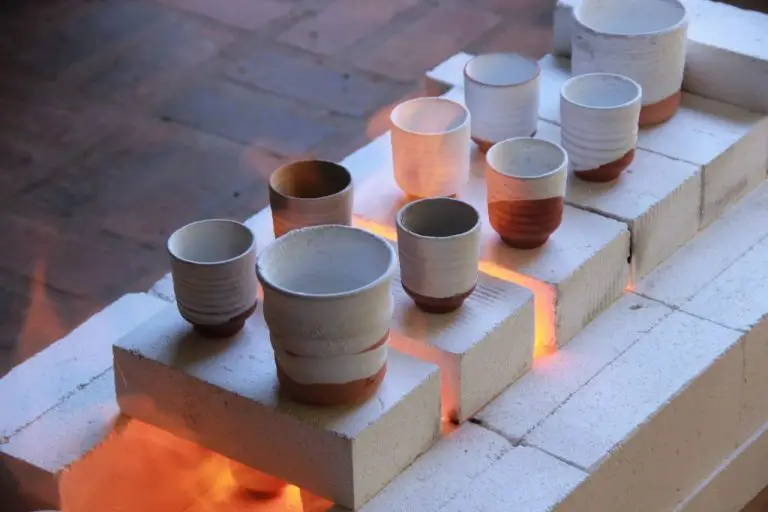Clay Exploration: Diving Into Earthenware, Stoneware, And More
Clay is a naturally occurring material composed primarily of fine-grained minerals like kaolinite, illite, and montmorillonite. Clay deposits are typically formed over long periods from the gradual chemical weathering of rocks. There are many different types of clay, but the three main categories are earthenware, stoneware, and porcelain.
Earthenware is a porous clay that fires at lower temperatures, typically between 1,750-2,100°F. It’s used to make decorative and functional pottery, tiles, and bricks. Stoneware is less porous, vitrifies at higher temperatures around 2,200-2,400°F, and is commonly used for pottery, tableware, and art. Porcelain is the most refined clay, firing between 2,200-2,450°F. It has very low porosity and is known for its whiteness and translucency. Porcelain is often used to create delicate tableware and figurines.
Beyond pottery, clay has many applications including bricks, roof tiles, floor and wall tiles, pipes, and refractory linings for high temperature kilns and furnaces. Clay is truly a versatile material that has been used by humankind for thousands of years.
Source: https://gasworksnyc.com/products/a-history-of-clay
Origins of Clay
Clay is formed from the gradual chemical weathering of rocks over long periods of time. The feldspar and mica minerals within rocks slowly break down when exposed to water and carbon dioxide, forming clay particles (https://ancientpottery.how/how-is-clay-formed/). This weathering process can take thousands to millions of years.
Geologically, clay deposits originated in the Precambrian period, over 600 million years ago. But major clay formations occurred in the Mesozoic and Cenozoic eras. Alluvial clay deposits are often found along river banks, formed by the erosion of rocks and transportation by water (https://ancientpottery.how/where-is-clay-found/). Lacustrine clay beds can also form on dried lake beds over time.
Today, large clay deposits are found across the world. In the United States, major clay sources include the Gulf Coast, Midwest, and Southeast regions. High-quality kaolin clay is mined extensively in Georgia. Other clay varieties like ball clay, fire clay, and common clay are readily available across the country (https://thepotterywheel.com/where-is-clay-found/).
Clay Composition
The chemical composition of clay varies depending on the type of clay. Clays are composed primarily of fine-grained minerals such as kaolinite, illite, and smectite as well as other minerals like quartz and feldspar.
The key differences in chemical makeup between the main types of clay are:
- Earthenware clay – Has a high iron and calcium content which causes it to be more porous and coarser when fired. Its chemical composition includes various minerals like kaolinite, illite, feldspar, and quartz.
- Stoneware clay – Has higher amounts of fluxes like feldspar that vitrify and turn glassy when fired at high temperatures around 1200°C-1300°C. It lacks the iron content of earthenware clay.
- Porcelain clay – Its main mineral is kaolinite which gives it a fine, white appearance when fired. It has very low impurities and minimal fluxes, requiring extremely high firing temperatures of 1300°C-1400°C.
These chemical differences lead to varying physical properties for each type of clay and how they respond to firing in a kiln.
Working with Clay
Working with clay requires a series of steps to prepare and shape the material. Here is an overview of common techniques:
Preparing Clay
Before clay can be shaped, it must be properly mixed and wedged to remove air bubbles and evenly distribute moisture. Most clays are purchased with the correct consistency, but some handmade clays require kneading or wedging by hand on a plaster slab 1.
Wedging
Wedging involves repeatedly cutting and slamming a lump of clay down onto a work surface to compress it. This removes air bubbles and creates an even consistency. Well-wedged clay is smooth, elastic, and free of cracks or dry spots 1.
Throwing
Using a pottery wheel, clay can be shaped by centering a lump on the wheel and applying pressure while spinning the clay. Common thrown forms include bowls, vases, cups, and plates. Throwing takes practice to master but allows precise shapes and thin walls.
Handbuilding
Shaping clay by hand offers more organic, asymmetrical forms. Pinching, coiling, and slabs are common techniques. Handbuilt pieces may be left as is or refined on the wheel. Firmer clays are often used for best results.
Firing
After drying, clay must be fired in a high temperature kiln to permanently harden it into a ceramic material. Different firing temperatures produce earthenware, stoneware, or porcelain. The clay body and firing method influence the final color, porosity, strength and other qualities.
Earthenware Clay
Earthenware clay is a plastic, porous clay fired at lower temperatures compared to other clays. From Dispatch.jcu.edu, the typical firing range for earthenware is between
Earthenware clay is ideal for making vases, pots, and other decorative pieces. The porous quality helps absorb stains and glazes nicely. When unglazed, the coarse texture provides an attractive finish. Earthenware clays come in a variety of natural earth tones like red, brown, and terracotta. The ancient Greeks and Chinese perfected earthenware pottery techniques centuries ago. Some examples today include traditional flower pots, garden ornaments, and handcrafted kitchenware.
Stoneware Clay
Stoneware clay is a type of clay that is very commonly used in pottery and ceramic art. It is valued for its high plasticity, as well as its ability to be fired at high temperatures ranging between 2,200°F to 2,600°F. Unlike earthenware clays, stoneware vitrifies and becomes non-porous when fired at high temperatures, making the finished wares more durable and water resistant.
Some key properties and uses of stoneware clay include:
- Has good plasticity that makes it easy to work with.
- Can be fired at high temperatures, resulting in a strong, vitrified and nonporous finished product.
- Resistant to thermal shock, which allows stoneware to withstand sudden temperature changes without cracking.
- Impervious to water absorption due to the vitrified nature.
- Available in various colors including grey, buff, red, brown due to natural impurities like iron and calcium.
- Commonly used to create everything from tableware and cookware to pottery and sculpture.
The firing process is important for stoneware clays. Firing temperatures typically range between 2,200°F to 2,600°F. During the vitrification stage between approximately 2,200–2,400°F, the clay particles partially melt, causing the clay to become nonporous and rock-like. Glazes are also often applied before firing to create colorful finishes.

Some examples of stoneware pottery and ceramic wares include mugs, plates, bowls, vases, and other functional items with excellent durability.
Porcelain Clay
Porcelain clay is among the purest types of pottery clay. It consists of fine kaolin clay along with potash feldspar and quartz. According to Collins Dictionary, porcelain clay is “a fine white clay used for the manufacture of hard-paste porcelain and bone china and in medicine as a poultice and gastrointestinal absorbent.”
Porcelain clay has very fine particles and low iron and impurity content, giving it a white color when fired. It becomes vitrified and translucent at high kiln temperatures between 1200°C and 1400°C (2192°F – 2552°F). Due to its high fusion point, porcelain clay can be fired to create hard, durable ceramic wares.
Porcelain clay is commonly used to create tableware, artware, sanitaryware and electrical insulators. Famous examples include fine china dinnerware like Limoges porcelain from France and bone china from England. Porcelain clay produces ceramic pieces that are smooth, strong and resistant to chipping.
Clay Bodies
There are three main types of premixed clay bodies – earthenware, stoneware, and porcelain. Each type has different characteristics and is suited for different applications.
Earthenware clay contains lower levels of fluxes than stoneware and becomes soft at lower temperatures, around 1000°C to 1200°C. It’s very workable and absorbs water easily, making it a good choice for handbuilding and pottery like ceramic planters. Some common earthenware clays are terracotta and red clay. Earthenware is porous when fired unless glazed. (Kilnarts)
Stoneware clay contains higher levels of fluxes and becomes vitrified at higher temperatures, usually around 1200°C to 1300°C. The higher vitrification makes stoneware less porous and more durable than earthenware. It’s commonly used for functional pottery like mugs, plates, and bowls. Stoneware has high plasticity and can be used for handbuilding or wheel throwing. (Wheel & Clay)
When choosing a clay body, consider the firing temperature, your desired working properties, and the final use of the piece. Earthenware works well for decorative and non-functional items fired to lower temperatures. Stoneware is better for functional ware fired to higher temps for more durability. Test different clay bodies to see which one suits your project best.
Clay Tools
Clay artists use a variety of specialized tools for sculpting, carving, shaping, and finishing their clay creations. Some of the most common basic clay tools include:
- Needle tool – A needle mounted on a wooden handle used to etch fine details and lines into clay. The sharp point allows for precision.
- Rib – A rounded, blunt metal or wooden tool used to smooth clay surfaces, remove excess clay, and compress forms. Ribs create smooth, even textures.
- Cutter – A wide, flat blade mounted on a handle used to trim and slice slabs and blocks of clay. Cutters create clean, straight edges.
- Loop tool – A wire or nylon loop on a handle used to smooth clay and create grooves and lines. The loops come in various sizes.
- Sponge – A porous sponge used to soak up slip and smooth clay surfaces. Sponges help remove texture.
- Scraper – A rectangular metal tool with a straight edge used to trim excess clay from surfaces and create flat, smooth areas.
- Rolling pin – Used to roll and flatten slabs of clay and imprint textures.
These basic hand tools allow clay artists to manipulate the clay into any shape imaginable. Most clay tool sets include an assortment of needles, loopers, ribs, cutters, and more. Many tools can also be fashioned by hand from wood, plastic, or metal (Pottery with a Purpose). As artists gain experience working with clay, they learn which tools work best to achieve different techniques and textures.
Notable Clay Artists
Some of the most famous ceramic artists known for their innovative work in clay include Grayson Perry and Betty Woodman.
Grayson Perry is an English contemporary artist who works in multiple media but is best known for his ceramic vases. He often decorates the pots with colorful motifs and text commenting on society, relationships and himself. His work combines excellent craftsmanship with satire and autobiography.
Betty Woodman was an American ceramic artist influenced by painterly expressionism. She pushed the boundaries of ceramic art in her unconventional slab-built pots and wall installations. Woodman brought a playful, colorful and decorative sensibility to contemporary ceramics. Her work integrated industrial and handmade elements in visually stunning combinations.



